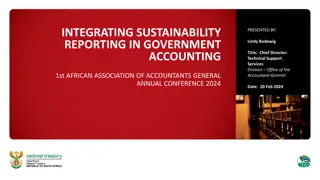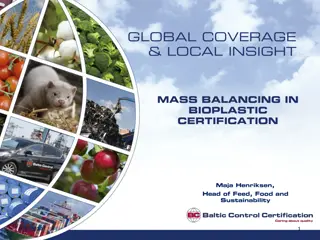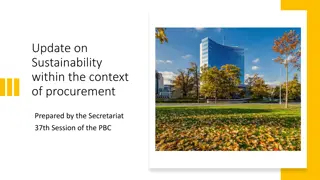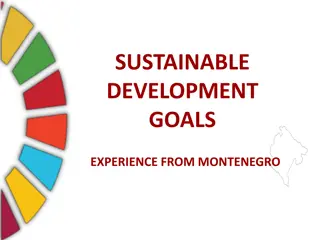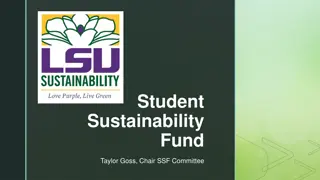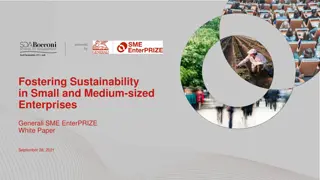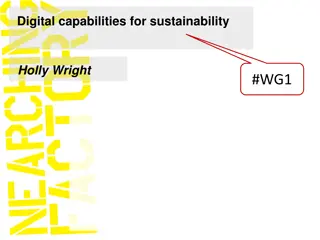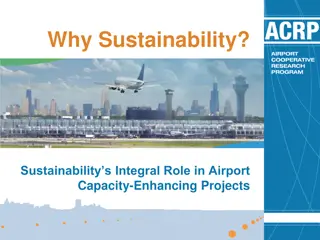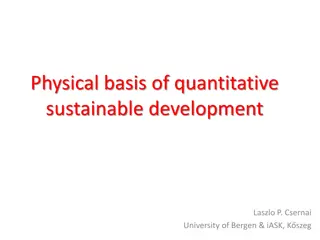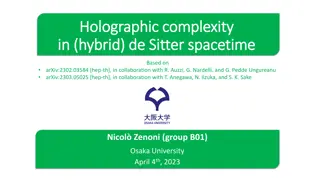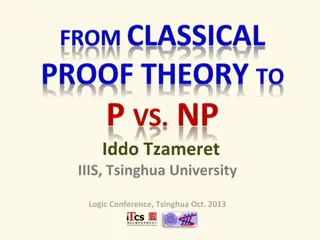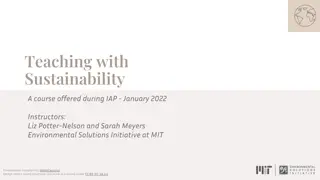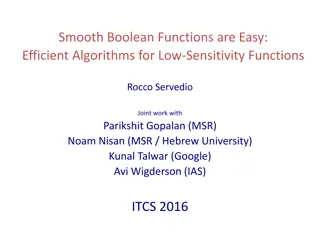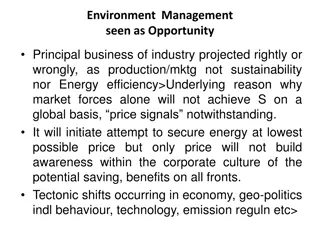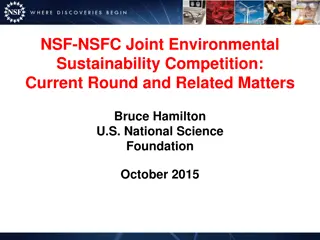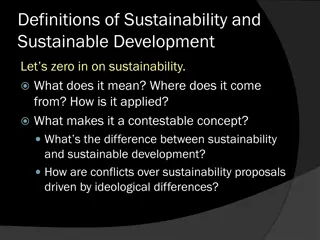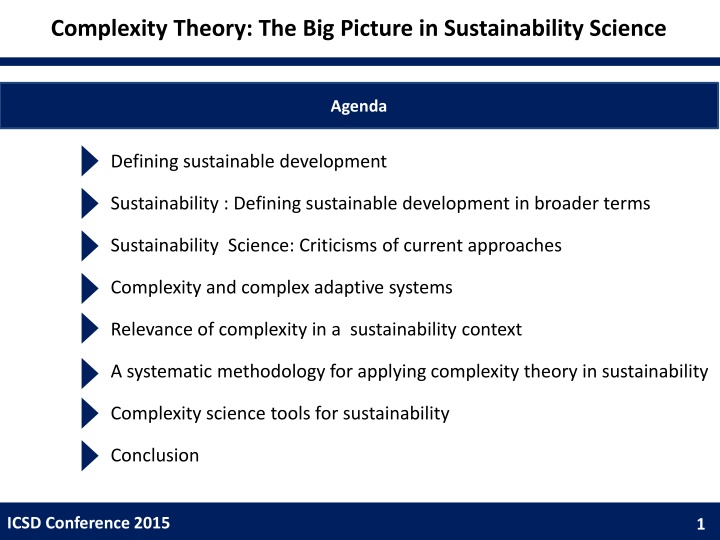
Complexity Theory in Sustainability Science: Defining Sustainable Development
Dr. Fawehinmi discusses the complexity theory's role in defining sustainable development within a broader context. Criticisms of current approaches, relevance in sustainability, and tools for application are explored systematically.
Download Presentation

Please find below an Image/Link to download the presentation.
The content on the website is provided AS IS for your information and personal use only. It may not be sold, licensed, or shared on other websites without obtaining consent from the author. If you encounter any issues during the download, it is possible that the publisher has removed the file from their server.
You are allowed to download the files provided on this website for personal or commercial use, subject to the condition that they are used lawfully. All files are the property of their respective owners.
The content on the website is provided AS IS for your information and personal use only. It may not be sold, licensed, or shared on other websites without obtaining consent from the author.
E N D
Presentation Transcript
Complexity Theory: The Big Picture in Sustainability Science Agenda Defining sustainable development Sustainability : Defining sustainable development in broader terms Sustainability Science: Criticisms of current approaches Complexity and complex adaptive systems Relevance of complexity in a sustainability context A systematic methodology for applying complexity theory in sustainability Complexity science tools for sustainability Conclusion ICSD Conference 2015 1
Profile: Dr Fawehinmi Degrees Executive Education MIT Sloan Executive Certificate in Leadership & Management; November 2014 BDS (University of Lagos, Nigeria; 1983) MBA (University of Leicester, UK; 2010) Certificate in Complexity Science; Santa Fe Institute, New Mexico USA; March 2014 Msc (Merit) Public Policy & Management ; University of London, 2011) Member of The New England Complex Systems Institute, Cambridge, Massachusetts, USA Phd Candidate (Public Policy, De Montfort University, Leicester, UK) 2012-till date ICSD Conference 2015 2
Sustainability Science: Have we got it inside out? ICSD Conference 2015 3
What is Sustainable Development? The concept of Sustainable development according to Martens (2006) is messy because it is by nature complex, normative, subjective and ambiguous Sustainable development is development which meets the needs of the present without compromising the ability of future generations to meet their own needs - Brutland Commission (WCED 1987) Robinson (2004) argues that this definition is vague, problematic and incomplete. His perspective privileges the term sustainability over the concept of sustainable development in the conviction that: The term sustainable development, with its connotations of growth; preferred by governments and the organized private sector, as opposed to the term sustainability favoured by academics and NGO s suggests an under-appreciation of environmental constraints ICSD Conference 2015 4
Sustainability: A Wider Definition of Sustainable Development Robinson s (2004) definition of the concept of sustainability is based on ecological/environmental, economic and social imperatives Ecological Imperative: To maintain the biophysical carrying capacity of the planet Economic Imperative: To provides an adequate material standard of living of all Social Imperative: To provide systems of governance that propagate the values that people want to live by 5 5 ICSD Conference 2015
Sustainability Science :The Challenges Sustainability science ambitiously aspires to address a range of human-nature challenges disaggregated as: Energy crises The environment and climate change Population growth Impact on pollution on health Health care concerns Ecosystem protection Food and security issues Biodiversity protection Resources production and management Global economic & financial risks ICSD Conference 2015 6
Criticisms of Sustainability Science (1) Current approaches to sustainability science have been criticised as being too siloed (2) Sustainability scientists have been charged with approaching sustainability from a premise of inadequate understanding of the complex dynamics of human environment systems According to Carpenter (2009) : The gaps in knowledge that exists today cannot be addressed through uncoordinated studies of individual components by isolated traditional disciplines To address these deficiencies, calls are growing for a robust conceptual framework for sustainability science based on an understanding of the phenomenon of complex adaptive systems with complexity theory as its theoretical backbone. ICSD Conference 2015 7
What is Complexity? Complexity according to Fernando, S.V (1990) is better explained than defined. Sage (2004) suggests that a system can be described as complex: when we cannot understand it through simple cause-and-effect relationships or other standard methods of system analysis. In a complex system, we cannot reduce the interplay of individual elements to the study of each of them in isolation. Often several different models of the complete system, each at a different level of abstraction are needed ICSD Conference 2015 8
Complexity Science: The Clarion call I think the next century will be the century of complexity Stephen Hawking, 2000 Source: ladypushing80wordpress.com, mylovelyquotes.com ICSD Conference 2015 9
Complexity Science: The Trailblazers (1940s 50s) Ludwig von Bertalanffy Norbet Wiener W Ross Ashby Systems Biology & Systems Theory Founder Cybernetics - Mathematics Cybernetics of the Mind Source: math.tufts.edu, blogerma.ru, optimizacionlinealsergioblogspots.com ICSD Conference 2015 10
Challenges of Defining Complexity: A Chinese Box Phenomenon A generally accepted definition of complexity is elusive because of the phenomenon s wide scope and variability All proposed definitions suffer from incompleteness Per Bak (1996) has referred to complexity as a Chinese box with surprises in each box A plethora of definitions of complexity have been proposed focusing on System size Entropy Algorithmic information content (AIC) Logical depth Thermodynamic depth Fractal dimension Computational capacity Statistical complexity Degree of hierarchy ICSD Conference 2015 11
A Broad Definition of Complexity (I) Goldin & Mariathasan (2014) have suggested that there are three levels of complexity; each with its own characteristic features The three levels are: Small-tent Complexity Often referred to as the Santa Fe complexity. Its features include: Locally interacting agents No central/global controller Cross-cutting hierarchical organization Continual adaptation Perpetual novelty Little tendency to global equilibrium ICSD Conference 2015 12
A Broad Definition of Complexity (II) Big-tent Complexity this is broader in scope. It s features includes: Small - tent complexity as described above Cybernetics Catastrophe theory Chaos theory Meta- Complexity Includes every other definition (the 45 definitions catalogued by Seth Lloyd) and in theory can cover several distinct definitions Goldin & Mariathasan, The Butterfly Effect: How Globalization creates Systemic Risks and What to do about it (2014) Princeton University Press. ICSD Conference 2015 13
Characteristics of Complex [Adaptive] Systems (I) In complexity science, the distinction is often made between complex systems that are intelligent and capable of adapting to their environment and non- adaptive systems. In sustainability science, our particular interest is in complex adaptive systems; which exhibit the following characteristics: Adaptability: Agents interact and change their behaviour in reaction to the behaviour of other agents Emergence: System exhibits patterns of continuous unpredictable novelty. A process whereby the global system results from the actions and interaction of agents (Sawyer; 2005) Self-organized criticality/Phase transition: The concept describes a self- organizational mechanism of abrupt transitions in large scale systems that may be triggered by small events (earthquakes, stock market crashes avalanches etc). The Sandpile metaphor ICSD Conference 2015 14
Characteristics of Complex [Adaptive] Systems (II) Chaos: Complex systems exhibit constantly changing hard to predict behaviour[chaotic dynamics].The defining feature of such a system is sensitive dependence on initial conditions . A classic [metaphoric] example of sensitivity to initial conditions is the butterfly effect the action of a butterfly flapping its wings somewhere on the planet resulting in a hurricane elsewhere. Order,(due to an underlying attractor) is often seen in chaotic systems. This chaotic effect has been mathematically proven Non linearity: Due to positive and negative feedbacks in combination, Complex systems processes are not linear causality is not proportional to effect. Effects may be larger than causes. Powerlaws: Complex systems sometimes exhibit probability distributions that obey a decreasing mathematical function known as a power law. The probability of events such as earthquakes, floods storms follow power laws. ICSD Conference 2015 15
Complex Systems: Self Organization, Emergence & Adaptive Behaviour Source: en.wikipedia.org ICSD Conference 2015 16
Emergence in Complex Systems Source: http://www.tcd.ie/futurecities/research/energy/adaptations-complex-systems.php ICSD Conference 2015 17
Complexity theory & Science: The Opinion Camps Chambers (1997) has identified three well delineated academic camps of opinion regarding the question of complexity theory being a paradigm shift or not. The Champions : Who are strongly persuaded by the ideas of complexity theory offering deep paradigmatic insight The Pragmatists: Who think complexity offers interesting and useful parallels and are ready to embrace its potential for social sciences and human organization The Critics: Who see complexity in the light of an insignificant coincidence ICSD Conference 2015 18
Complexity Science: Relevance to Sustainability Fedrof , N (2013) in a clear advocacy for a complexity science approach to sustainability posited that: The earth and its inhabitants are the most complex system we know but we don t yet have either a theory of complexity or an experimental approach to manage this system our global system wisely Seidler & Bawa (2004) summoned the association between complex adaptive systems and coupled human systems remarking that: Most of the challenging questions today are posed in contexts that meet the criteria for so called complex adaptive systems. These criteria include extensive interaction of and aggregation of diverse components, adaptation, non-linearities, emergent properties, amplifier effects ICSD Conference 2015 19
Sustainability: Examples of Complex adaptive Coupled Human systems Emergent phenomena a hallmark characteristic of complex adaptive systems is observed across a spectrum of coupled human-environmental systems. Such as: Economies Financial Markets Cities Ecosystems The Biosphere Weather Health Systems ICSD Conference 2015 20
Applying Complexity in Sustainability Andries et al (2009) have offered a systematic methodology for applying complexity thinking in sustainability based on four themes as the basis of application. Characterise and Understand Complex Human Environment Systems (HESs) Develop typologies of classes of HESs and match classes with properties Understand Local Adaptive responses and Global consequences Decision makers need to predict global effects better and avoid basing decisions/plans on local situations and short time scales Characterise Trade-Off s in HESs Understand making environment/development trade-offs is critical to producing better sustainability outcomes Disciplines and Methods Required Integration of theoretical and modelling predictions of complex adaptive systems with empirical evidence from actual human environment systems ICSD Conference 2015 21
Complexity Science Tools for Sustainabilty Science Through advances in computing and simulations, complexity science provides powerful decision support tools for sustainability. Two promising approaches are : Agent-based modelling(ABM) Network Analyses Well suited for : Representing social interactions and autonomous behaviours Studying the environmental impact at different scales For studying the emergence of adaptive response to changing environment and environmental policies Social network analyses can help reveal the characteristics of individual actors and the dynamic modification of their behaviours over time ICSD Conference 2015 22
Explaining Agent Based Modelling Agent-based Simulation is a New Field Grounded in the Biological, Social, and Other Sciences What is an agent? A discrete entity with its own goals and behaviours Autonomous, with a capability to adapt and modify its behaviours Assumptions Some key aspect of behaviours can be described. Mechanisms by which agents interact can be described. Complex social processes and a system can be built from the bottom up. Examples People, groups, organizations Social insects, swarms Robots, systems of collaborating robots Agents are diverse and heterogeneous Macal, C.M & North,M.J (2006) Argonne National Labs ICSD Conference 2015 23

